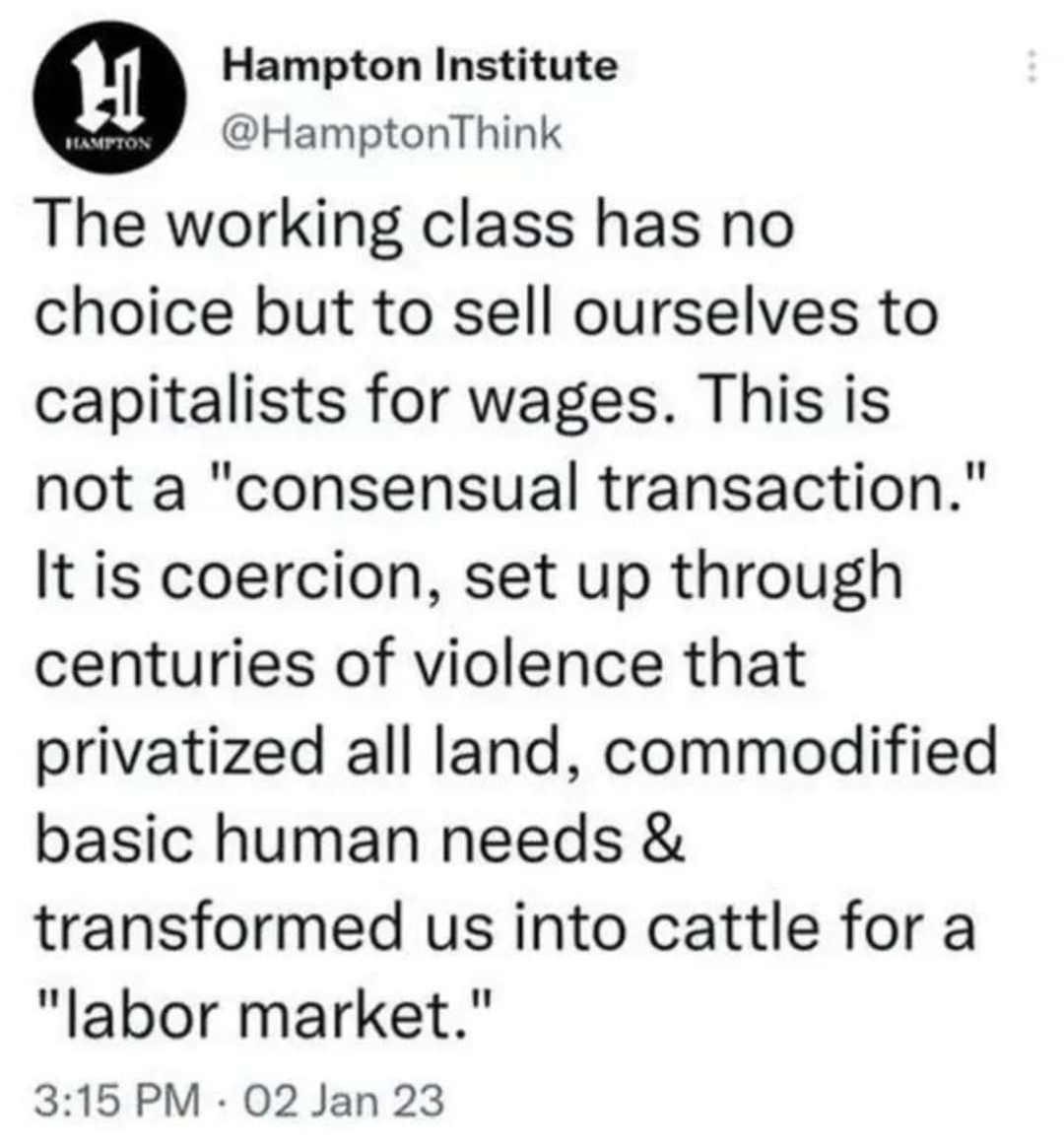this post was submitted on 27 Feb 2024
1271 points (93.9% liked)
Microblog Memes
5863 readers
3908 users here now
A place to share screenshots of Microblog posts, whether from Mastodon, tumblr, ~~Twitter~~ X, KBin, Threads or elsewhere.
Created as an evolution of White People Twitter and other tweet-capture subreddits.
Rules:
- Please put at least one word relevant to the post in the post title.
- Be nice.
- No advertising, brand promotion or guerilla marketing.
- Posters are encouraged to link to the toot or tweet etc in the description of posts.
Related communities:
founded 1 year ago
MODERATORS
you are viewing a single comment's thread
view the rest of the comments
view the rest of the comments

In the case of capitalism, we are actually speaking about coercion, though. The concept of "primitive accumulation" (or "primary accumulation"), as introduced by Karl Marx in his critique of political economy, refers to the historical process that led to the formation of capitalism by separating the producer from the means of production. This separation is what ultimately pushed people into the capitalist labor market, making them dependent on selling their labor to survive. The coercive forces that pressured people into capitalism and the labor market can be understood through several key mechanisms:
Enclosure of the Commons: In England and elsewhere in Europe, land that was previously held in common for collective use by peasants was enclosed, privatized, and turned into private property. This process forced many peasants off the land, depriving them of their traditional means of subsistence and making them dependent on wage labor.
Colonialism and Slavery: The expansion of European powers into the Americas, Africa, and Asia involved the appropriation of land and resources, often through violent means. Indigenous peoples were displaced or enslaved, and their resources were extracted for the benefit of European capitalist economies. This not only facilitated the accumulation of capital but also integrated various regions into the global capitalist system.
Legislation: Laws and regulations played a crucial role in this process. For example, the series of laws known as the "Poor Laws" in England were designed to coerce the unemployed and poor into working for wages. These laws restricted the movement of labor and made it illegal to refuse work, effectively pushing people into the labor market.
Destruction of Alternative Economies: Pre-capitalist forms of production and exchange, such as feudalism, communal living, or barter systems, were systematically destroyed or undermined. This was not only through direct coercion but also through economic policies and practices that favored capitalist modes of production and exchange.
Industrial Revolution: The technological advancements of the Industrial Revolution created a demand for labor in factories. The rural populations, already dispossessed by the enclosure movements, migrated to urban centers in search of work, further entrenching the wage labor system.
Marx argued that primitive accumulation was not a one-time historical event but an ongoing process that sustains capitalism. It involves continuous dislocation and dispossession to maintain a labor force that has no other choice but to sell its labor power. This process ensures a supply of workers for the capitalist system and maintains the conditions necessary for capital accumulation.
In essence, the transition to capitalism, fueled by these coercive forces, created a society where the majority must sell their labor to a minority who owns the means of production, thereby establishing the capitalist labor market and perpetuating the cycle of capital accumulation.
Thanks for taking the time to do this informative write-up.
Yes, that is very well gathered, and something people don't intuitively understand how it shapes us over (only a few) generations.
Chatgpt is that you D: